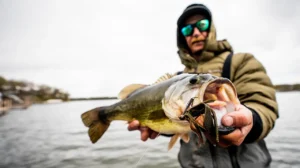I was just a child, no more than 10 years old, when I went fishing at a small lake near our home in Birmingham, Alabama, with my father and my grandfather. It was May — bluegill time. We were motoring around a point in a 12-foot jon boat when they both suddenly perked up.
“I smell ‘em,” my dad said.
I took a big whiff, and the smell of fish was overpowering; it was like walking near the seafood counter at your local grocery store after they’d just received a big delivery. We anchored down right there, started casting with redworms and crickets, and caught big bluegill until we had no space left in the cooler.
That was the day I learned how valuable your nose can be when you’re searching for bluegill beds in spring. But somehow, some folks still don’t believe you can smell them on the beds. Don’t be convinced by the non-believers.
“As far as being able to find where a bed is exactly, maybe not,” says Randy Zellers, assistant chief of communications for the Arkansas Game and Fish Commission. “But you can definitely tell when you’re in the right area, especially in shallower water.
“Scent is really helpful in muddy or stained water when you can’t see their beds. They are communal spawners. They don’t just have one or two beds here and there. They load up in there, and they definitely produce some scent.”
Zellers pointed out that old-school methods like smelling bluegill on their beds combine well with today’s modern technology.
“We all know that side-imaging [sonar] is almost cheating when it comes to looking for bluegill beds,” he said. “But it’s incredibly effective when you smell fish and you can’t quite locate them. Once that smell tells you you’re in the right area, side-imaging will lead you the rest of the way. It’s a great combo.”
The Pull of the Moon

Another bit of wisdom my elders shared with me is the role the full moon plays in igniting the bluegill spawn. My dad used to say the best time to fish for bluegill is from three days before the full moon and three days after.
“That’s about spot on,” Zellers said. “Usually the full moon in May, sometimes the full moon in June.”
He was clear that’s not the only time you can catch bluegill — just the best time.
“It’s not a magical one-night thing,” Zellers pointed out. “Some bluegill are even active in those beds 15 days later. It’s not just that everybody runs up there and moves in right away. But that period three days before until three days after is definitely the peak time.”
Water Temperature
A wise man — and one of the best friends I’ve ever had is a guy named Bill Dance. Maybe you’ve heard of him. He won a few Bassmaster events back in the day, and he’s quite possibly the most famous fishing TV star in history. He once told me something about water temperature and bluegill beds that I couldn’t believe.

“They are not as sensitive to warm water as a lot of people think,” Dance said. “If you can find water as cool as 80 degrees, you’re likely to find bluegill on the beds.”
Zellers wasn’t about to argue with a man who’s seen and done as much on the water as Dance. But he said he couldn’t give a firm answer about water temps and spawning bluegill.
“As far as an exact temperature, it’s hard to say,” Zellers admitted. “They certainly don’t all move up at the same time. Just like young men at the bar, you’re gonna have some who show up early and some who show up late. Who knows the reason?”
The easiest way to know is to let the fish tell you.
“They are very territorial and don’t like anything around their beds or even their buddies’ beds,” he said. “It doesn’t take long to find an active bed. If they’re in there, they’ll bite. If things seem dead, they’ve either been fished out or it’s gotten too warm for them.”
Can You Catch Too Many Bluegill?

People have different opinions on this matter, and the truth is, the answer differs depending on where you’re fishing.
“In lakes and large bodies of water, you can wipe out a bed and sometimes it’ll take a while to recover,” Zellers said. “But then there are times when you can wipe out a bed one week, and new fish will move in and take over that same bed the next week. Those original fish were there because it’s a good place to bed.”
Zellers said the invention of LiveScope has opened many people’s eyes to just how many fish are in large bodies of water.
“It’s amazing,” he said. “We used to see it to an extent with electro-sampling. But LiveScope has revealed a whole new world. You can hurt a bluegill population, even on large bodies of water. But states have limits in place to keep us from wiping them out — and there are just so many more out there than we ever believed.”
The story is certainly different on small bodies of water with less carrying capacity.
“If it’s a small pond, then yes you can wipe them out,” Zellers said. “But even then, there’s a lot more fish out there than you probably realize. People who’ve never spent time looking with [sonar] probably just wouldn’t believe it.
“It will blow your mind.”












